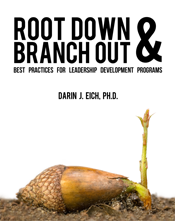During my research on high quality leadership programs – interviewing more than sixty stakeholders about what matters most for student learning and leadership development – I rarely (if ever) heard that the following program elements were contributing positively to student learning and leadership development.
Here is a list of what I didn’t hear:
 1. Lecturing about a book. This may be hard for you to do and may also be hard for the students to stay alert for.
1. Lecturing about a book. This may be hard for you to do and may also be hard for the students to stay alert for.
2. Assigning a lot of reading. Many times students won’t even remember what they are reading while they are reading it.
3. Corporate case studies. Do you have much in common with General Electric? I didn’t think so.
4. Studying famous leaders. Do you have a lot in common with Stonewall Jackson? I didn’t think so.
5. Quizzes. I hope students have a good memory.
6. Exams. I hope students have a really good memory.
Many of these elements are traditional foundations of college courses, and many are prevalent in leadership courses and programs across the country, but in general, you need validated “roots that work” to branch your program out. My new book, Root Down & Branch Out: Best Practices For Leadership Development Programs, brings key findings to practice from research conducted to determine the most important characteristics of high-impact leadership development programs. What contributes most to student learning and leadership development, and how can you design your program, course, or educational experience better?
The Grounded Theory Model of High Quality Leadership Programs describes:

• 16 roots – or positive attributes – that serve as a strong foundation for your program
• 40 branches – or actions – that bring the positive attributes to life in your program
• 34 acorns – or outcome effects – that are a result of positive attributes and actions
These attributes, actions, and effects are organized into three clusters that help you to grow your program:
Cluster One: Participants Engaged in Building and Sustaining a Learning Community
Cluster Two: Student-Centered Experiential Learning Experiences
Cluster Three: Research grounded continuous program development
The important lesson here is to build upon what works. Perhaps you have assessed your own program and have discovered that quizzes and exams contribute significantly to student learning and leadership development. If so, you may be a rare case, but build upon it. My guess is that the lecture listening, textbook reading, and quiz answer memorizing that students do generally doesn’t matter as much for their learning and development as a leader than working on real projects in teams, and then reflecting and making meaning on that to strategize better for future leadership projects.
In my student leadership education book I’ve included sixteen best practices for you to consider growing from, many of which may already be working in your program. Others will be new ones to experiment with. The path forward is simple: do more of what is working and less of what isn’t. Just because you’ve inherited it, others are doing it, or you have done it in the past doesn’t mean you should keep on doing it. Grow your program and leadership development naturally… with is already working. Take a look at what works in your program and root down and branch out from it.
To demonstrate, here are some “branch out” ideas for what you could try based on the “what doesn’t work” examples I started with.
1. Lecturing about a book. Instead, branch out and try bringing in a guest leader to tell their real stories.
2. Assigning a lot of reading. Instead, try having students develop and present their own ideas.
3. Corporate case studies. Do you have much in common with General Electric? I didn’t think so. This looks too much like reading. Instead, have them create a case about a real experience they have had, maybe something in their student organization that others could identify with.
4. Studying famous leaders. Do you have a lot in common with Stonewall Jackson? I didn’t think so. Have students study themselves through self-assessments or interview someone they know.
5. Quizzes. Instead, try a reflection journal or portfolio students are building over time.
6. Exams. Instead, try a final team project where they do something for real…such as something the students choose and are passionate about or a service project.
Thanks to Dr. Dan Jenkins for his research on leadership education pedagogies and collaboration on this idea. If you are heading to the Leadership Educators Institute at Ohio State be sure to look for the session he will be presenting – What Doesn’t Work in Undergraduate Leadership Education. I hope I can join him there!